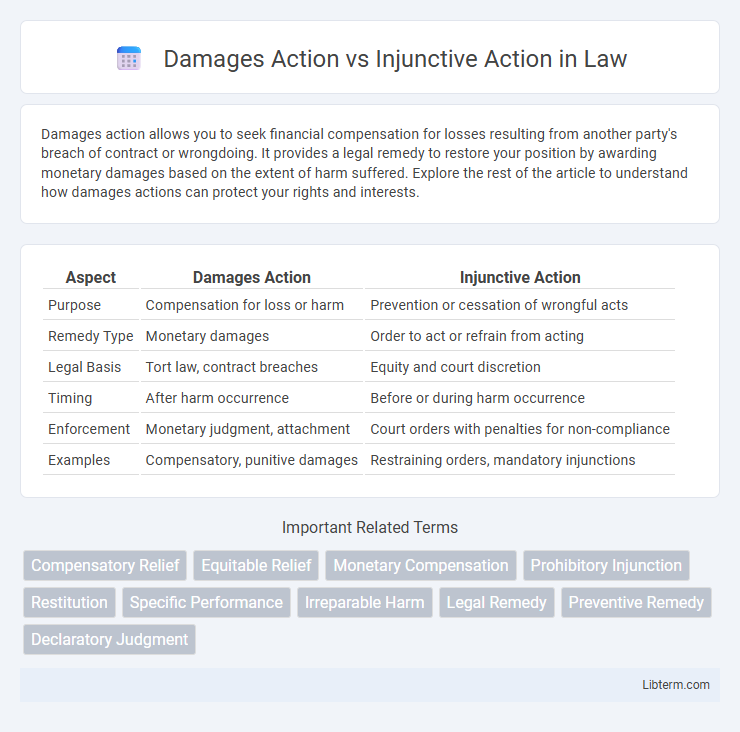Damages action allows you to seek financial compensation for losses resulting from another party's breach of contract or wrongdoing. It provides a legal remedy to restore your position by awarding monetary damages based on the extent of harm suffered. Explore the rest of the article to understand how damages actions can protect your rights and interests.
Table of Comparison
| Aspect | Damages Action | Injunctive Action |
|---|---|---|
| Purpose | Compensation for loss or harm | Prevention or cessation of wrongful acts |
| Remedy Type | Monetary damages | Order to act or refrain from acting |
| Legal Basis | Tort law, contract breaches | Equity and court discretion |
| Timing | After harm occurrence | Before or during harm occurrence |
| Enforcement | Monetary judgment, attachment | Court orders with penalties for non-compliance |
| Examples | Compensatory, punitive damages | Restraining orders, mandatory injunctions |
Introduction to Damages Action and Injunctive Action
Damages action is a legal remedy seeking monetary compensation for losses caused by a defendant's wrongful act or breach of contract, aiming to restore the injured party's financial position. Injunctive action involves a court order requiring a party to do or refrain from specific acts to prevent irreparable harm or preserve rights. Both remedies serve distinct purposes in civil litigation, with damages addressing compensation and injunctions focusing on prevention or cessation of harm.
Definition of Damages Action
A Damages Action is a legal remedy seeking monetary compensation for harm or loss caused by another party's wrongful conduct. It involves quantifying the financial impact of damages such as loss of property, personal injury, or breach of contract. This action is distinct from Injunctive Action, which aims to prevent or stop ongoing or future harm through a court order.
Definition of Injunctive Action
Injunctive action is a legal remedy that compels a party to do or refrain from specific acts to prevent harm or enforce rights. Unlike damages action, which seeks monetary compensation for loss suffered, injunctive relief addresses ongoing or potential future harm through court orders such as temporary restraining orders or permanent injunctions. Courts grant injunctive actions to maintain status quo or protect legal interests when damages are inadequate or insufficient.
Key Differences Between Damages and Injunctive Actions
Damages actions seek monetary compensation for harm caused by another party's breach of duty, emphasizing quantifiable financial loss, whereas injunctive actions aim to prevent or require specific conduct to avoid ongoing or future harm. Damages are retrospective, addressing past injury, while injunctions are prospective, focusing on preventing further damage or enforcing rights. The choice between these remedies depends on the nature of the harm, with courts issuing injunctions to halt irreparable damage when monetary compensation is insufficient.
Legal Basis for Damages Claims
The legal basis for damages claims is rooted in tort law, contract breaches, or statutory violations, requiring proof of harm, causation, and liability to recover monetary compensation. Damages actions aim to compensate the plaintiff for losses incurred due to the defendant's wrongful conduct, with types including compensatory, punitive, and nominal damages. The claimant must establish a clear legal duty breached by the defendant, resulting in quantifiable injury, distinguishing it from injunctive actions that seek court orders to prevent or mandate specific behavior rather than monetary redress.
Legal Grounds for Seeking Injunctive Relief
Legal grounds for seeking injunctive relief primarily include the need to prevent irreparable harm that cannot be adequately remedied by monetary damages. Courts grant injunctive actions to maintain the status quo, prevent ongoing or imminent violations of rights, or protect unique interests such as trade secrets, intellectual property, or contractual obligations. The plaintiff must demonstrate a likelihood of success on the merits and that the balance of equities favors issuance of the injunction.
Procedural Steps in Filing Damages Action
Filing a damages action involves drafting a complaint that clearly states the harm suffered and the legal basis for compensation, followed by serving the complaint to the defendant in accordance with jurisdictional rules. The plaintiff must then gather and present evidence during discovery, participate in pre-trial motions and hearings, and comply with procedural deadlines to move the case towards trial. The court will ultimately assess liability and quantify the monetary damages based on the proof provided.
Procedural Requirements for Injunctive Action
Injunctive actions require strict procedural requirements, including the filing of a verified complaint showing irreparable harm and lack of an adequate remedy at law. Courts often mandate a detailed affidavit or sworn statement supporting the necessity of the injunction to prevent injustice during trial. Unlike damages actions, injunctive measures usually necessitate immediate notice to the opposing party and may involve a hearing for a preliminary injunction.
Practical Examples and Case Studies
Damages action involves seeking monetary compensation for loss or injury, exemplified by the landmark case *Hadley v. Baxendale*, where a plaintiff recovered damages for delayed delivery losses. Injunctive action aims to prevent or stop a wrongful act, as seen in *eBay Inc. v. MercExchange*, where the court granted a permanent injunction to halt patent infringement. Practical application depends on whether a financial remedy suffices or whether immediate cessation of harmful conduct is necessary to protect legal rights.
Choosing Between Damages and Injunctive Actions
Choosing between damages action and injunctive action hinges on the nature of the harm and the desired outcome; damages actions seek monetary compensation for losses incurred, while injunctive actions aim to prevent or stop ongoing or future harm through court orders. Legal practitioners assess factors such as the adequacy of monetary relief, the immediacy of harm, and the feasibility of enforcement before advising clients. Injunctive relief is often preferred in cases involving intellectual property or ongoing breaches, whereas damages are suitable when quantifiable financial loss has already occurred.
Damages Action Infographic

 libterm.com
libterm.com